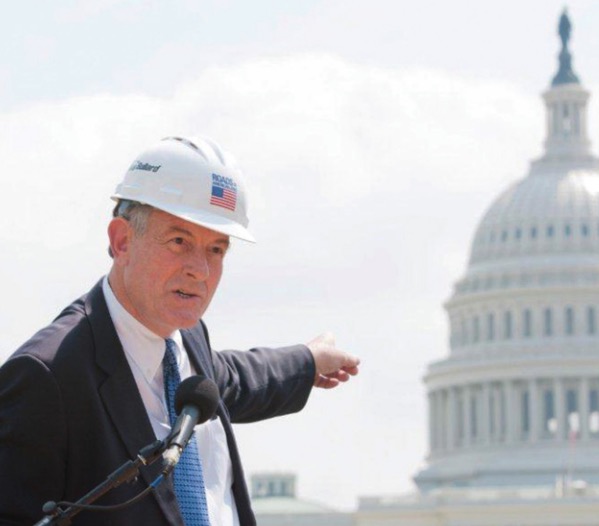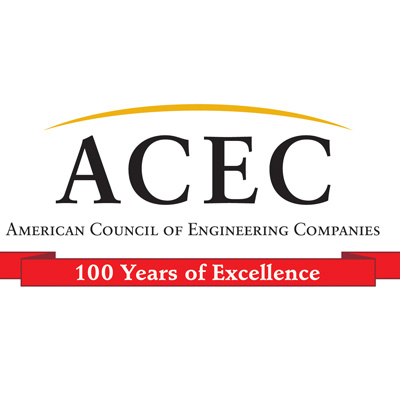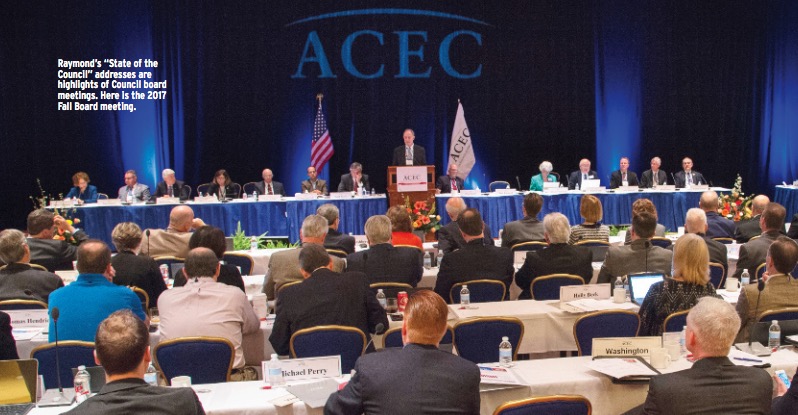AMERICAN COUNCIL OF ENGINEERING COMPANIES (ACEC)
Written by Calvin Hennick
 Over the past two decades, the American Council of Engineering Companies has grown in membership and stature, and become a powerful voice on Capitol Hill, and in state capitals throughout the nation—with outgoing President/CEO Dave Raymond at the center of it all.
Over the past two decades, the American Council of Engineering Companies has grown in membership and stature, and become a powerful voice on Capitol Hill, and in state capitals throughout the nation—with outgoing President/CEO Dave Raymond at the center of it all.
When Dave Raymond took over leadership of the American Council of Engineering Companies in March 1999, he knew the job was right for him. He did not know he’d become a “lifer.”
“With my background in both engineering and public service, I thought my qualifications were a good fit, and the role offered me a new challenge,” says Raymond, who will retire from his post this spring after nearly two decades of service.
“I didn’t think of a time limit, but I certainly didn’t think I’d be here until retirement,” he adds.
Raymond came to the organization after 20 years in the engineering industry, with executive experience at firms around the country, including Raytheon and Enserch Corp. He’d also worked for a U.S. senator on Capitol Hill and had roles at executive branch agencies.
When he arrived at ACEC, he says, he found a “sleepy” association in need of a jump-start. But, as he got to work, Raymond became excited by the possibilities of turning the organization into what members now call a “powerhouse.”
“It was presented to me as an organization that had great potential but was not operating on all cylinders,” Raymond recalls.
“When I came here, I found that was an apt description. So, we got busy. We brought in many capable people who have performed very well, and we’ve empowered staff to do much more than they ever could before. I could see the fruits of the effort that was being put in. We were pleased and excited by the outcomes, and it was fun, as well.”
Those outcomes include membership growth, improved relations with state organizations, major legislative and regulatory wins, and one of the country’s largest political action committees, as well as world-class communications, educational programming and conferences.
“When Dave arrived, we were an organization that offered education programs to its members, and we did a reasonably good job at that, but we were not very effective as a lobbying entity,” says Terry Neimeyer, CEO at the Marylandheadquartered KCI Technologies, and chairman of ACEC from 2011 to 2012. “You go to Washington, D.C., and talk to any of the folks in power, and they know who ACEC is. That, to me, has been Dave’s biggest legacy.”
“I’ve seen a move to excellence on almost every level,” says Mary Ann Emely, ACEC’s vice president and COO, who joined the staff in 2001. “Over the years, we’ve replaced every staffer who left with a higher-qualified person. We’ve built a top-level team. Everything is being done at a much higher level than it was 15 or 20 years ago, and our members recognize that. Dave wanted to build a top-tier organization, and we’ve accomplished that.”
Bigger and Stronger
While there’s no single metric for judging the strength of an industry association, membership levels and staff quality are good places to start. In both cases, Raymond and ACEC set new standards.
Over the past 20 years, the portion of eligible ENR Top 500 Design Firms that are ACEC members increased from 70 percent to a current 87 percent (including 90 percent of the ENR Top 100). ACEC now has more than 5,000 Member Firms, representing more than 600,000 A/E professionals.
Membership growth has reflected ACEC’s ability to demonstrate the enhanced value of the organization. “They have found us to be a hard-hitting organization working on behalf of their interests,” Raymond says.
To improve quality of staff, Raymond says he not only pushed for more competitive compensation, but also made a point of giving people leadership opportunities and empowering them to make decisions and solve problems. Emely recalls, “On the day he hired me, he told me he never wanted me to agree with him just because he’s the boss.”
Jerry Stump, CEO of Volkert, Inc., and 2010–2011 ACEC chairman, calls the ACEC staff and leadership one of the greatest strengths of the organization and one of the greatest transformations over the past two decades. “The professionalism of the staff is impressive and lends even greater strength and credibility to the organization,” Stump says. “They do an outstanding job of running the organization while being accessible to and responsive to our Member Organizations and Member Firms.”
Stakeholders within ACEC also credit Raymond with strengthening ties between the national organization and the now 52 state and regional chapters or “Member Organizations.” In 2000, the national organization changed its name from “American Consulting Engineers Council” to “American Council of Engineering Companies” in recognition of its firm-based membership and a “desire to appeal to a wider audience both within and outside the industry,” according to Raymond. Over subsequent years, each of the Member Organizations adopted the new ACEC brand as their name and by doing so also subscribed to a potentially more effective and mutually reinforcing alignment between the national office and the state organizations.
“When I came to ACEC, relations between state organizations and the national organization were strained, and what we’ve tried to do is develop more of a family dynamic, where each part of the organization is bolstered by strengthening another part,” says Raymond.
“Dave has listened to the leaders in the states,” says Alison Davis, executive director of ACEC/Oregon. “If someone has a comment or a question about something, Dave takes it seriously. He’s really worked hard to make it so that we’re all working together.”
A Powerful Advocate
In conversations with ACEC stakeholders about the most significant changes during Raymond’s tenure, the topic of political influence is always mentioned. The organization has several specific legislative and regulatory notches on its belt (see “Wins on Capitol Hill”), but there’s also a more general sense that the organization now has the ear of power brokers in Washington, D.C., and in state capitals in a way that didn’t exist two decades ago.
“ACEC is viewed as a leader by representatives and senators,” says Neimeyer. “A decade ago, they would have just laughed at us and said, ‘Who are you?’ Now, they know who we are.”
Lawmakers also recognize ACEC as a trusted resource when it comes to engineering, says Ronald W. Brenke, executive director of ACEC/Michigan. “I now receive unsolicited calls from members of Congress in my state who would like to talk about various issues affecting our infrastructure. This did not happen 10 years ago,” he says.
“Basically, we have doubled our influence on Capitol Hill,” says Janice Burnett, executive director of ACEC/Arizona.
ACEC’s political influence is bolstered by its political action committee (ACEC/PAC), which under Raymond has grown from around $100,000 in contributions per year to a previously unthinkable $1 million—a number reached by the PAC for the past two years—and pro – viding ACEC $2 million in spending power for each two-year congressional election cycle. ACEC/PAC now ranks in the top 3 percent of all federal PACs nationwide.
“When we got to the halfway point, to $500,000, people said, ‘We’ll never be able to raise a cent more, let’s just call it a day,’” Raymond notes, “but we said no, we’re going to reach our goal.”
“I have members who ask why we’re involved in lobbying and comment, ‘Isn’t that a dirty business?’ “My answer is, ‘No, it’s not a dirty business at all.’ On the contrary, it’s very American. We believe that people who have good judgment, who share our own values, should be helped. That has been the basis for our PAC.”
Steve Hall, vice president of government affairs at ACEC, who previously worked for several members of Congress, says he was only vaguely aware of ACEC before joining the staff in 2001. “It didn’t really have a big profile. I think its members probably always understood the importance of lobbying, but probably didn’t appreciate what was possible. We put wins on the board.”
Eric L. Flicker, senior consultant at Pennoni Associates and the Council’s 2003–2004 chairman, praises the organization’s access to key legislators, the White House, and regulatory agencies and says that the group’s political influence extends beyond Washington. “This has translated to remarkable access at the state level, as well as with financial and leadership support for local issues,” he says. “ACEC understands the relationships between federal and state-and-local issues.”
Success at the state level is also due in part to ACEC’s Minuteman Fund, which supports legislative, regulatory and judicial efforts at the state level. Through a dollar-for-dollar matching program between the national organization and state Member Organizations, the fund, under Raymond, has grown from $100,000 to more than $2.5 million.
Adding Value Through Education
ACEC stakeholders say that the quality of the organization’s educational programming and annual events has also been substantially enhanced over time. Orrin B. “Mac” MacMurray, chairman of the organization from 2007 to 2008, and chairman emeritus of C&S Companies, says that ACEC’s business management education, highlighted by its Senior Executives Institute (SEI), is “unmatched in the industry.”
ACEC’s education programs featuring in-person seminars, online seminars and a host of specialized coalitions and forums are utilized each year by more than 10,000 members, representing 1,250 Member Firms.
Business Resources and Education Vice President Marie Ternieden pointed to Raymond as a key driver of the Council’s ability to provide business education that makes a difference. “The Council has developed ever-expanding and extensive educational programming, including our recent Pathways to Executive Leadership, and the growth of monthly online classes on a variety of critical and bottom-line focused business topics. We are poised for continued growth and a bright, successful future in educating the next generation of A/E business leaders.”
MacMurray noted that under Raymond, the organization’s communications and public relations efforts also has stepped up its game significantly. “When Dave arrived, the ACEC magazine was adrift and unfocused,” MacMurray says. “Today, Engineering Inc. is a national and international award-winning publication that’s admired and respected throughout the design and construction industry.
“Also, 20 years ago, it was rare to see ACEC quoted in the press. Now it happens all the time.”
Annual Meetings and Engineering Excellence Awards
During Raymond’s tenure, the annual Engineering Excellence Awards became the Academy Awards of the engineering industry—blossoming from a 150-person luncheon into a major black-tie Gala Dinner hosted by Hollywood celebrities and attended by more than 750 members and dignitaries from all over the world.
Over the past six years, attendance at ACEC’s Annual Convention has increased 35 percent to over 1,500, a result that Meetings and Conventions Executive Director Michael Pramstaller attributes to vastly improved programming.
“Part of the growth is definitely due to getting nationally renowned speakers,” Pramstaller says. Recent speakers have included historian Doris Kearns Goodwin, former CIA and NSA head Michael Hayden and oceanographer Robert Ballard.
Download full article (PDF): The Redesign of ACEC
Download full March/April issue of Engineering, Inc.
 About the American Council of Engineering Companies
About the American Council of Engineering Companies
www.acec.org
The American Council of Engineering Companies (ACEC) is the voice of America’s engineering industry. Council members – numbering more than 5,000 firms representing more than 500,000 employees throughout the country – are engaged in a wide range of engineering works that propel the nation’s economy, and enhance and safeguard America’s quality of life. These works allow Americans to drink clean water, enjoy a healthy life, take advantage of new technologies, and travel safely and efficiently. The Council’s mission is to contribute to America’s prosperity and welfare by advancing the business interests of member firms.
Tags: ACEC, American Council of Engineering Companies, Calvin Hennick, David Raymond, Engineering, Engineering Inc., Engineers







 RSS Feed
RSS Feed